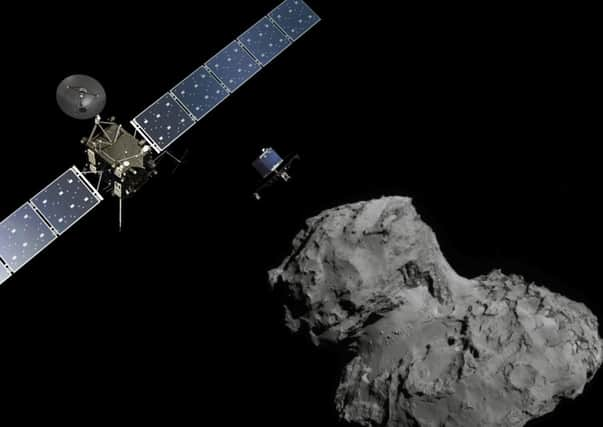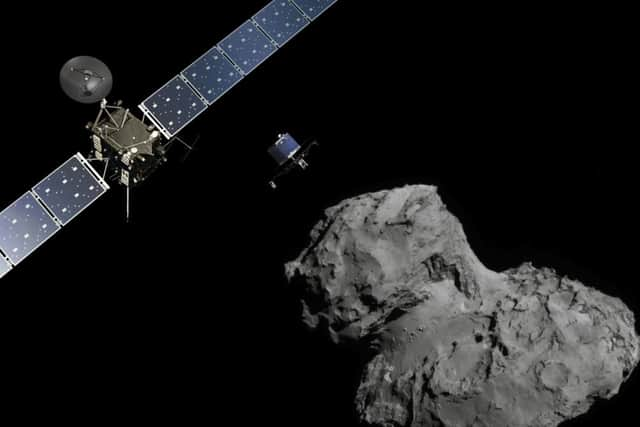Rosetta mission: Joy as spacecraft lands on comet


The Philae probe landed safely on comet 67P/Churyumov-Gerasimenko at the end of a four-billion-mile journey that began ten years ago.
A radio signal confirming the landing was received just after 4pm, after taking 30 minutes to travel 316 million miles to Earth.
Advertisement
Hide AdAdvertisement
Hide AdMission controllers had to endure a tense wait of almost seven hours as the spider-like craft descended to the surface of the comet, a 2.5 mile-wide rugged lump of ice and dust travelling at around 40,000mph.


When news of the landing came, ecstatic scientists at the European Space Agency (ESA) operations centre in Darmstadt, Germany, cheered, clapped and hugged each other.
For some, the event marks the culmination of 20 years of work.
It is the first time any man-made object has made a controlled landing on a comet. Nine years ago, Nasa’s Deep Impact mission smashed a projectile into comet Tempel 1. Philae, in contrast, drifted gently down at walking pace.
CONNECT WITH THE SCOTSMAN
• Subscribe to our daily newsletter (requires registration) and get the latest news, sport and business headlines delivered to your inbox every morning
Flight director Andrea Accomazzo said: “We can’t be happier than we are now.”
The Rosetta mission’s British project scientist Dr Matt Taylor said: “To see this effort, I can’t put words to it. It’s beautiful. We did a good job. I knew we were going to do it.”
The probe had travelled with its Rosetta mothership on an epic odyssey.
Advertisement
Hide AdAdvertisement
Hide AdSuccess was never certain. The comet is strewn with deep pits, towering cliffs and boulders – some the size of houses. The landing site, named Agilka after an island on the Nile in southern Egypt, was considered the least hazardous of several candidates.
As it touched down, two harpoons sprang from the probe to anchor it to the surface.
Earlier, there was a heart-stopping moment when the lander’s descent system, which uses thrust to direct the craft, could not be primed. Another glitch was fixed in the usual fashion – by switching Philae’s computer off and on again.
The separation from Rosetta involved a complex manoeuvre in which Rosetta “dive-bombed” the comet to put the lander on target, before veering away.
The Philae probe is equipped with cameras, ten instruments and a drill that can bore out samples to a depth of 9in.
The lander is designed to collect data for two and a half days, but Rosetta will remain with the comet as it flies past the sun.
Scientists hope the £1 billion mission will yield information about the origin of the Solar System, the Earth and possibly life.
Comets bombarded the Earth early in its history, helping to fill the seas with water and depositing complex organic chemicals which may have contributed to the birth of living things.
SEE ALSO
SCOTSMAN TABLET AND IPHONE APPS